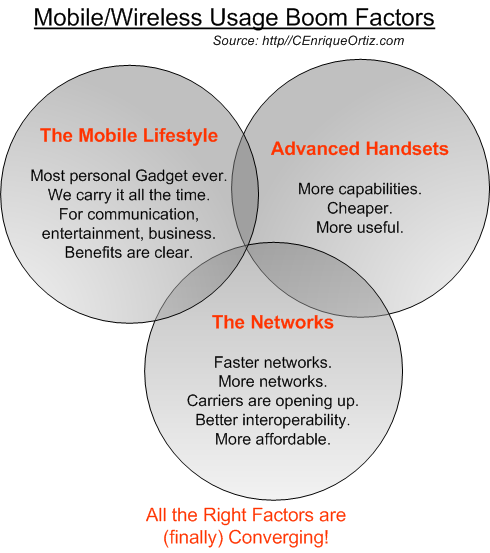
The Motorola Dyna-Tac, 1973. Specs: 9 x 5 x 1.75 inches, 2.5 pounds, 35 minutes of talk time.
While not fully consumed, a transformation that started more than 30 years ago is underway. It has been a slow and painful path while the market matures, but it is happening. This transformation is resulting on the initial phase of a true Mobile/Wireless Usage Boom.
But what is different today than let’s say, five years ago? Why is this boom happening now?
The answer lies on the true convergence or intersection of three factors, as illustrated next:

…where the following factors are finally converging:
- The Mobile Lifestyle: The mobile handset is the most personal gadget ever. If our handsets could talk, we would be in trouble. We carry it all the time; for communication, for entertainment, for business. For commerce. Thousands of text messages per month. Photos. Video. Music. Talk. Share. The threshold between personal and business mobile handsets is disappearing; even for handsets that are company-issued, people (not their manager) want to choose. The benefits are clear.
- Advanced Handsets: Mobile handsets are so powerful. More and more capabilities and usefulness. More and more functional and network convergence. Advanced hardware. Advanced software. But cheaper.
- The Networks: Faster networks. More networks. The networks carriers are opening up; they have no choice. Better interoperability between network carriers; roaming, billing. More affordable over time. Flat-rates.
The result of the above intersection, which is mainly driven by the mobile lifestyle, goes beyond usage boom, and is about critical mass. That is the true indicator of the market being ready.
Coincidentally, Ajit wrote a piece related to “critical mass”; see Personalization is not a substitute for critical mass – from Zagme to Blyk.
ceo
[Source of Dyna-Tac image: Motorola]
Pingback: Carnival of Mobilists #119 | mobilejones
Pingback: The Carnival and the Boom!
Pingback: On Data-mining, identity, digital footprint, and social context | (Mostly) About Mobility
Pingback: McGuire’s Law » Blog Archive » Indicators: Week of 4/13/08
Pingback: About Mobility » Blog Archive » On Reasons Why The Mobile/Wireless Usage Boom was Underway | Part 2